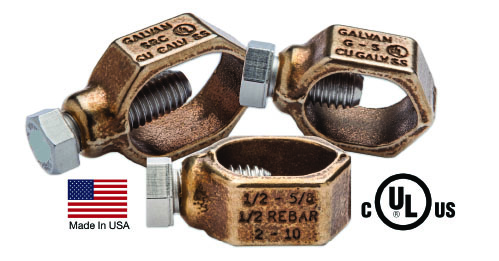This article relates to National Electrical Code (NEC) 250.70, which states:
“Methods of Grounding and Bonding Conductor Connection to Electrodes. The grounding or bonding conductor shall be connected to the grounding electrode by exothermic welding, listed lugs, listed pressure connectors, listed clamps, or other listed means. Connections depending on solder shall not be used. Ground clamps shall be listed for the materials of the grounding electrode and the grounding electrode conductor and, where used on pipe, rod, or other buried electrodes, shall also be listed for direct soil burial or concrete encasement. Not more than one conductor shall be connected to the grounding electrode by a single clamp or fitting unless the clamp or fitting is listed for multiple conductors. One of the following methods shall be used:
(1) A pipe fitting, pipe plug, or other approved device screwed into a pipe or pipe fitting.
(2) A listed bolted clamp of cast bronze or brass, or plain or malleable iron
(3) For indoor communication purposes only, a listed sheet metal strap-type ground clamp having a rigid metal base that seats on the electrode and having a strap of such material and dimensions that it is not likely to stretch during or after installation.
(4) An equally substantial approved means.”
An often-overlooked issue during ground rod installation pertains to the above portion of the code which states, “Ground clamps shall be listed for the material of the grounding electrode….”
This portion of the NEC has been discussed at several of the IAEI section meetings that were held around the country in 2018. There are several manufacturers that now offer acorn ground rod clamps that are listed for all three types of ground rods. Some of these clamps are also listed for rebar.
Ground rods are made of or coated by three materials: stainless steel, copper, and zinc. In many parts of the country, galvanized and stainless steel ground rods are used. Stainless steel ground rods are used where there are corrosive environments or where there is concern regarding the longevity of a ground rod in the soil. Galvanized ground rods have been successfully used in many areas of the country for decades. The sacrificial aspect of zinc coupled with its lower cost makes it appealing in the areas where galvanized ground rods can be used.
 Each type of ground rod—copper coated, zinc coated, or stainless steel—has varying finished diameter tolerances. Depending on the conductor wire size, a variance in diameter may result in a clamp with a bolt that is not long enough, and so it may not compress the ground conductor adequately. There have also been cases where a listed clamp was large enough to fit over a full-sized galvanized ground rod, but a stranded conductor of the largest size listed on the clamp could not be clamped properly, which resulted in an inadequate and therefore unsafe ground.
Each type of ground rod—copper coated, zinc coated, or stainless steel—has varying finished diameter tolerances. Depending on the conductor wire size, a variance in diameter may result in a clamp with a bolt that is not long enough, and so it may not compress the ground conductor adequately. There have also been cases where a listed clamp was large enough to fit over a full-sized galvanized ground rod, but a stranded conductor of the largest size listed on the clamp could not be clamped properly, which resulted in an inadequate and therefore unsafe ground.
The problem is that the majority of bronze alloy ground rod clamps have been tested and listed only for copper-coated (sometimes incorrectly referred to as copperclad) ground rods. They have not been tested and so are not listed for galvanized or stainless steel. If one of those clamps is installed on an electrode for which it is not listed, the installation does not meet Code! An Authority Having Jurisdiction (AHJ) encounters this non-Code-compliant installation numerous times during inspections of installed galvanized and stainless-steel ground rods.
This brings up one of the dilemmas faced by the electrical inspector: How does one inspect a rod once the rod is driven into the ground? Many jurisdictions have handled this dilemma by requiring the contractor to leave a shovel full of dirt away from the rod with the listed marking showing. All the inspector has to do is verify the existence of the listing mark, then immediately kick the dirt back over the installed rod. In addition to being manufactured to the correct length, the listing mark also assures the inspector that the rod has the correct diameter and the correct amount of zinc (galvanized) or copper coating. Though a rod does not have to be listed to meet the NEC, by viewing the listing mark, the AHJ then knows this rod was manufactured to the specifications needed to meet 250.52.A(5) of the NEC. Without viewing the listing mark, the inspector is just guessing that the installed ground rod meets the requirements of the NEC.
At the same time of inspecting the ground rod, the inspector can view the ground rod clamp to see if it is listed for the “material of the grounding electrode” as per NEC 250.70. Along with the listing mark, the reference to copper (cu), galvanized (galv), and stainless steel (ss) should be found on the ground rod clamp indicating that it has been listed for a ground rod of that material.
The entire inspection process for the ground rod and clamp only takes a few seconds. By doing this simple, quick inspection, the AHJ can verify that the installation is Code compliant.
In conclusion, the only way to be sure the ground installation is Code compliant is to visually inspect both the ground rod and the ground clamp for the listing mark and to inspect that the clamp has been listed for the material of the ground rod as is required by the NEC.
Jim Lund has a Masters degree from Pepperdine and a bachelors degree from University of Wisconsin-Madison. He is a member of IAEI, NEMA, CANENA, and others. He presently is a director at Galvan Industries and has worked in the electrical field for 28 years.














Find Us on Socials